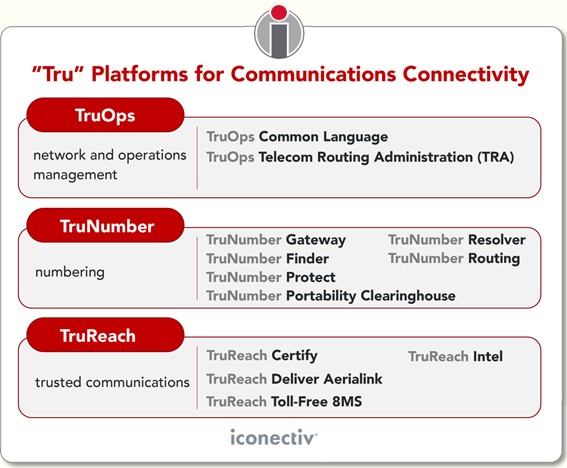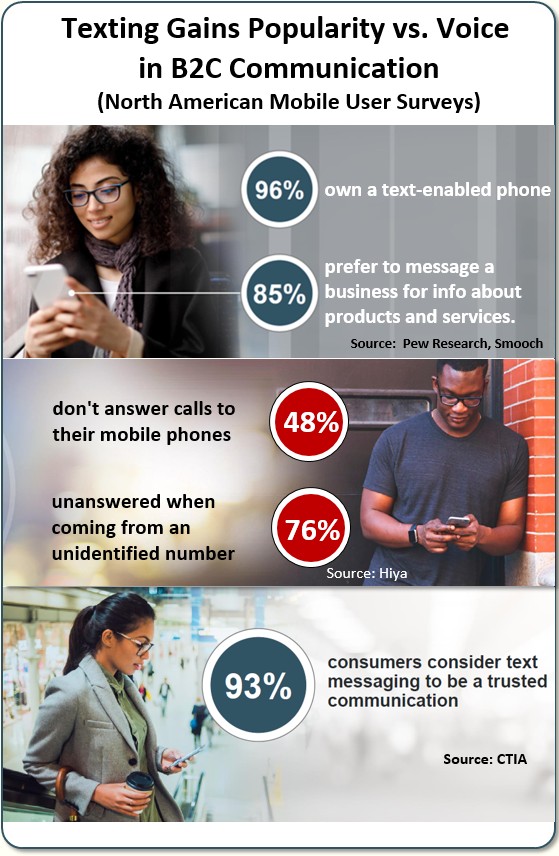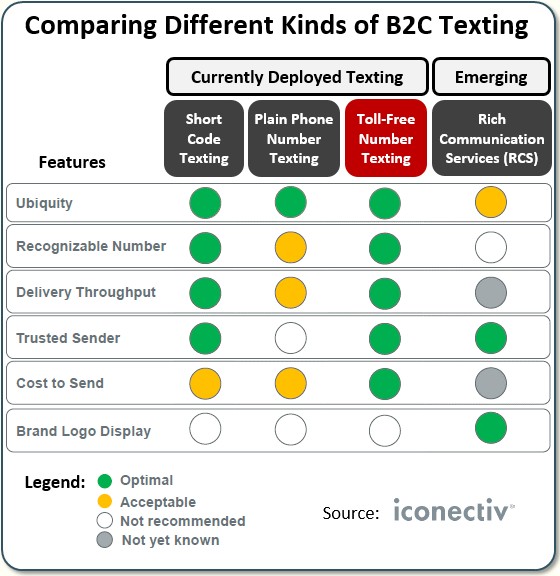| © 2022 Black Swan Telecom Journal | • | protecting and growing a robust communications business | • a service of | |
| Email a colleague |
October 2020
Convenient & Spam-Free: Why 800-Number Texting (8MS) is a Growing B2C Channel in North America

In my high school biology class, I learned about systems — biological systems. We studied the anatomy of frogs to identify major animal organs and learn the function of various systems — nervous, circulatory, digestive, and respiratory.
And perhaps because a teenager’s attention span is pretty short, my teacher never talked about any secondary bodily systems that are absolutely vital to human life. For instance, connective tissue exists throughout the human body: it helps bind organs together, stores fat, helps repair tissue damage, and protects against disease.
Telecom itself is a kind of biological creature. Its fixed and mobile networks connect to organs like switches, servers, cross-connects, and phones. Plus, there are vital operating systems, like billing, provisioning, sales/marketing, finance, and service assurance.
And if you look closer, you’ll also find connective tissue: systems for phone number management, fraud control, security, revenue assurance, and many others. If this connective tissue was not there, the communications business would surely collapse — or be run over by the digital giants.
So this is a roundabout way of introducing iconectiv, a key supplier of telecom connective systems, and the company I interviewed for this story.
iconectiv traces itself to Bellcore, a company formed in 1984 when the Bell telephone system, which dominated U.S. telephony, was broken up. This is when the original AT&T was formed as a Long Distance operator. Separately, another seven independent Regional Bell Operating Companies (RBOCs) were formed, each covering their own local telephony territories.
Bellcore was created at divestiture to manage their common network operating issues and to build vital systems. Thus, Bellcore became a major architect of the U.S. telecom system, pioneering many connective services, such as caller ID, call waiting, mobile number portability and toll-free telephone number (800) service.
It also pioneered the prepaid charging system and the Intelligent Network.
In 1996, Bellcore was sold and renamed Telcordia. Then 15 years later, Ericsson acquired the firm, merging Telcordia’s provisioning, inventory and other systems into its main business — and also spinning off iconectiv as an independent subsidiary with a mission to keep managing and creating new connective systems for the betterment of the telecom business.
So what’s iconectiv up to these days? Well, that’s the purpose of the below chart showing the three major “platforms” it supports:

- TruOps focuses on network and operations;
- TruNumber covers systems for number portability and also its global allocated
phone number database, TruNumber Protect, used in fraud control; and
- TruReach which delivers B2C communications enhancements such as TruReach
Certify (iconectiv’s systems for managing SHAKEN/STIR Calling Number Verification),
TruReach Intel, TruReach Deliver Aerialink and TruReach Toll Free 8MS, the subject
of the interview below.
Now iconectiv is not the only firm building connective systems. A key competitor is Neustar out of Sterling, Virginia. Both these firms focus primarily on North America, but are increasingly active worldwide. For instance, iconectiv administers number portability in more than a dozen countries around the world, including in India. Both firms administer national SHAKEN/STIR programs: iconectiv in the U.S.; Neustar in Canada.
The following interview is about iconectiv’s text-enabling B2C communications program. Product Manager, Michael Gilbert briefs us on these programs following iconectiv’s August 2019 acquisition of CSF, a leader in the text enabling and delivery space.
| Dan Baker, Editor, Black Swan Telecom Journal: Michael, sounds like there’s a lot of activity happening in SMS or texting. That’s great because it’s a major revenue contributor to telecoms and we need to stay ahead of the WhatsApp’s of the world. Can you explain a bit of the history of text-enabling phone numbers and the solutions iconectiv acquired? |
Michael Gilbert: Absolutely, Dan. Over the past few years, texting has gone through a kind of Wild West phase where a lot of innovation came in. Here are the two key assets iconectiv acquired:
- TruReach Aerialink provides fast and reliable SMS and MMS message delivery
to over 1,200 mobile network operators in 220 countries. Their gateway
scales to deliver millions of real-time SMS and MMS messages with guaranteed
uptime of 99.95%; and,
- TruReach Toll-Free 8MS is the SMS equivalent of calling toll-free 800-numbers
— 3-digit prefixes like 800, 877, and 888 — that North American
businesses use for branding and customer service.
Basically, an enterprising firm came up with a way to enable carriers to avoid having to look-up toll free numbers. And that meant 8MS traffic could be sent down one pipe and the toll-free database could be accessed by any RespOrg — a Responsible Organization, such as a carrier or licensed OTT provider.
So now when you text 1-800-Flowers, the 8MS message will come from your mobile phone and it will be distributed to the person who is handling the text for that number. And interestingly, the text provider can be different from your voice provider. So you could have iconectiv as your texting provider and a company like Bluetone doing the voice side. In short, the customer can choose best of breed.
| Something I was not aware of until now is you can also text-enable toll free phone numbers, not just business regular phone numbers. |
Yes, actually there are three forms of text-enabling today:
- Short codes — These are the familiar six-digit numbers you see
on SMS messages such as 888-111 or 242-424. Businesses pay $500-$1000
per month for either a random or vanity number like these. Telecoms make
their big money serving large enterprises.
Large text campaigns, say a large beverage manufacturer, would use short codes where they might pay sub-penny rates per message. The biggest companies send 20 million or more messages a month, so that adds up to a good business for a telco — and it’s a must-have marketing channel for the enterprise.
- Regular Business phone numbers (long codes) — Say you’re
a small doctor’s office, and you want to send out reminders saying, “You’ve
got an appointment tomorrow”, and your customers know your phone number,
then your office can text customers back and forth using the local phone number.
This is very economical: the business might pay $10 a month plus a few cents
a message.
- 8MS (texting to toll-free numbers) — One of the biggest flower
delivery companies in the U.S. is 1-800-Flowers, so for them, conversing with
customers using their 800-number is a natural extension of their branding/name
recognition, and a convenient way of taking orders and doing business.
It’s also a way to send coupons to customers via texting.
Toll Free is steadily growing. Today there are 42 million active toll free numbers in North America (U.S. and Canada), but only 10 percent of them have been text-enabled — so we have a long way to go and iconectiv is leading the way.
| So why is texting catching on as a way to contact businesses? |
Well, the biggest reason is that text is increasingly preferred over voice. For instance, 76% of people in the U.S. will not answer an unidentified number. And 48% won’t answer any phone call except from friends or family.
And the neat thing about text is it’s widely available. 96% of people own a text-enabled phone — and it’s built into the phone so it doesn’t require downloading an app.
About 85% of people prefer sending a message to a business to get information about products and services. Indeed, the habit of asking questions through a call center is steadily declining, especially among younger people.
Best of all, 93% of people consider text a “trusted communication”. And I can tell you a lot of effort and regulation went into making text secure. In particular, the carriers have done a great job of closing the door on spam through the use of filters. Now an SMS provider like iconectiv has its own filters for monitoring spam. The key is to make sure the consumer has opted into a particular merchant.

| Looks like there’s some nice opportunity for growing in 8MS. How are you going to market? |
We definitely believe that 8MS is golden nugget a lot of people haven’t noticed quite yet. Marketing 8MS is a matter of reaching the right people and explaining: “Hey, there’s another revenue stream out there for you.”
Today there’s confusion about which numbers to use, the text communication platform, plus compliance opt-in issues.
But there are two audiences we need to reach: the large enterprises and the carriers.
On the carrier side of 8MS, there are about 100 RespOrgs involved. And these are your major carriers, CPaaS providers, and conference companies.
Now, the challenge for them is they’ve focused on voice — those are the kind of contracts they are providing to their customers. There’s also a more technical side of implementing 8MS. It’s important to get the billing system onboard and provide a portal where their customers can sign up for 8MS service.
On the enterprise side we’re reaching out to some of the larger companies in a few key industries:
- Insurance — Some of the big insurance firms absolutely love 8MS.
They like the way it enables them to send notices about premiums or to alert
customers that a document was sent to their email inbox. For auto insurance
firms, if there’s a car accident, the customer can get on the phone, take
a picture of the accident scene, and text in the report directly to expedite
processing the claim.
- Banking — One bank sends customers notices on every single deposit
or withdrawal from an account. It’s being well received because
it allows customers to monitor their bank balances and identify suspicious charges.
- Auto Dealers text-enable multiple numbers so messages can be redirected to the different departments: some to sales, and others to customer support. And if it’s time for an oil change, the support team might send a coupon to the customer.
All and all, text-enabled numbers are a fast and efficient way to communicate back and forth and not waste time and it’s the preferred way for customers to engage with businesses. A win-win!
| If you get enough companies text-enabling their toll-free numbers, then pretty soon the consumer is going to expect that. |
Yes, that becomes an issue for a lot of these big consumer brand companies. For instance, if you were to text a toll-free number and write, “I’d love to buy roses for my grandmother,” but you get nothing back, the consumer might say, “What’s wrong with this company that they don’t return my text message?” But, in truth, maybe the company never text-enabled the toll-free number.
So realizing this issue, what we’ve done is gone to some of the bigger companies and said, “Hey let us text-enable your toll free numbers and monitor the traffic you receive to find out if a significant number of people are trying to connect with you in this way. And we’ll report back to you and give you a log of text message inquiries.”
We did that with a large cable company in Philadelphia and they were amazed to see thousands of text messages coming in every day. And the irony is they were already making phone calls to customers telling them their bills were overdue and not getting calls back.
So it made good sense for this cable company to text-enable their customer support lines.
Over time, it will become a liability to firms that don’t text-enable conversations with their customers — particularly if their competitors are doing so.
| How does the business or enterprise manage all these messages coming in? |
Well, if it’s a doctor’s office, maybe they assign one of their staff to handle the messaging traffic flow. We provide a portal similar to Outlook. We have an application we call “Conversations” that people can set up in one day.
But if a customer already has an application like this, we can send messages to them via an API. There’s also an industry protocol called Short Message Peer-to-Peer (SMPP) they can connect to directly, making for easy integration.
The beauty of managing by text is you can have simultaneous conversations. So it might actually be more convenient for the agent to be using this rather than call center interaction.
| OK, what’s the future look like, Michael? And what about the multimedia version of texting, Real Time Communications (RCS)? How will that impact the texting space? |
Dan, at iconectiv, we definitely feel texting has a huge upside. About 8.3 trillion text message are sent in North America per year, and yet 61% of businesses are not using SMS/MMS to communicate with their customers.
The chart below compares the features of the different kinds of text-enabling.
As you can see, Toll-free Number Texting (8MS) compares favorably with short code texting.
Now regarding RCS, yes, it’s an emerging standard that enables multimedia texting. But at least for now, toll free number texting is a great value, mobile users love it, and it’s gaining traction.

| Michael, thanks for this fine briefing. Texting doesn’t get as much attention as it deserves, but you make the point that in terms of trust and convenience, it has key advantages. Good luck in driving the adoption of toll-free texting. |
Copyright 2020 Black Swan Telecom Journal
Recent Stories
- Epsilon’s Infiny NaaS Platform Brings Global Connection, Agility & Fast Provision for IoT, Clouds & Enterprises in Southeast Asia, China & Beyond — interview with Warren Aw , Epsilon
- PCCW Global: On Leveraging Global IoT Connectivity to Create Mission Critical Use Cases for Enterprises — interview with Craig Price , PCCW Global
- Subex Explains its IoT Security Research Methods: From Malware & Coding Analysis to Distribution & Bad Actor Tracking — interview with Kiran Zachariah , Subex
- Mobile Security Leverage: MNOs to Tool up with Distributed Security Services for Globally-Connected, Mission Critical IoT — interview with Jimmy Jones , Positive Technologies
- TEOCO Brings Bottom Line Savings & Efficiency to Inter-Carrier Billing and Accounting with Machine Learning & Contract Scanning — interview with Jacob Howell , TEOCO
- PRISM Report on IPRN Trends 2020: An Analysis of the Destinations Fraudsters Use in IRSF & Wangiri Attacks — interview with Colin Yates , Yates Consulting
- Telecom Identity Fraud 2020: A 36-Expert Analyst Report on Subscription Fraud, Identity, KYC and Security — by Dan Baker , TRI
- Tackling Telecoms Subscription Fraud in a Digital World — interview with Mel Prescott & Andy Procter , FICO
- How an Energized Antifraud System with SLAs & Revenue Share is Powering Business Growth at Wholesaler iBASIS — interview with Malick Aissi , iBASIS
- Mobileum Tackles Subscription Fraud and ID Spoofing with Machine Learning that is Explainable — interview with Carlos Martins , Mobileum


